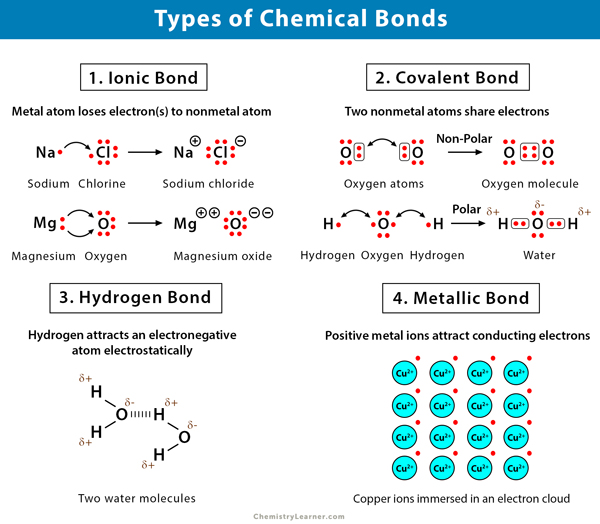Chemical Bonds
Definition: What is a Chemical Bond?
Chemical bonds are forces that hold the atoms together in a molecule. They are a result of strong intramolecular interactions among the atoms of a molecule. The valence (outermost) electrons of the atoms participate in chemical bonds. When two atoms approach each other, these outer electrons start to interact. Although electrons repel each other, they are attracted to the protons within atoms. The interplay of forces results in the formation of bonds between the atoms. The main types of chemical bonds are ionic bond, covalent bond, hydrogen bond, and metallic bond [1,2].
A bond between two atoms depends upon the electronegativity difference between the atoms. If the electronegativity difference is significantly high, the atoms transfer electrons to form ions and thereby form an ionic bond. If the electronegativity difference is zero or small, then the atoms combine to form covalent bonds.
Different Types of Chemical Bonds with Examples
1. Ionic Bond
As the name suggests, ionic bonds result from the attraction between ions. Ions are formed when an atom loses or gains an electron. These types of bonds are commonly formed between a metal and a nonmetal [1-5].
Examples
- Sodium (Na) and chlorine (Cl) combine to form stable crystals of sodium chloride (NaCl), also known as common salt.
- Magnesium (Mg) and oxygen (O) combine to form magnesium oxide (MgO).
- Potassium (K) and chlorine (Cl) combine to form potassium chloride (KCl)
- Calcium (Ca) and fluorine (F) combine to form calcium fluoride (CaF2)
2. Covalent Bond
In the case of a covalent bond, an atom shares one or more pairs of electrons with another atom and forms a bond. This sharing of electrons happens because the atoms must satisfy the octet (noble gas configuration) rule while bonding. Such a type of bonding is common between two nonmetals. The covalent bond is the strongest and most common form of chemical bond in living organisms. Together with the ionic bond, they form the two most important chemical bonds [1-7].
A covalent bond can be divided into a nonpolar covalent bond and a polar covalent bond. In the case of a nonpolar covalent bond, the electrons are equally shared between the two atoms. On the contrary, in polar covalent bonds, the electrons are unequally distributed between the atoms.
Examples
- Two atoms of iodine (I) combine to form iodine (I2) gas.
- One atom of carbon (C) combines with two atoms of oxygen (O) to form a double covalent bond in carbon dioxide (CO2).
- Two atoms of hydrogen (H) combine with one atom of oxygen (O) to form a polar molecule of water (H2O).
- Boron (B) and three hydrogens (H) combine to form the polar borane (BH3).
3. Hydrogen Bond
A hydrogen bond is a chemical bond between a hydrogen atom and an electronegative atom. However, it is not an ionic or covalent bond but is a particular type of dipole-dipole attraction between molecules. First, the hydrogen atom is covalently bonded to a very electronegative atom resulting in a positive charge, which is then attracted towards an electronegative atom resulting in a hydrogen bond [1,4-6].
Examples
- A hydrogen atom from one molecule of water bonds with the oxygen atom from another molecule. This bonding is quite significant in ice.
- In chloroform (CH3Cl) and ammonia (NH3), hydrogen bonding occurs between the hydrogen of one molecule and the carbon/nitrogen of another.
- A hydrogen bond holds together nitrogen bases present in DNA.
4. Metallic Bonds
A metallic bond is a force that holds atoms together in a metallic substance. Such a solid consists of tightly packed atoms, where the outermost electron shell of each metal atom overlaps with many neighboring atoms. Consequently, the valence electrons move freely from one atom to another. They are not associated with any specific pair of atoms. This behavior is called non-localization [1,2,4].
Examples
Other Types of Chemical Bonds
Neutral molecules are held together by weak electric forces known as Van der Waals forces. Van der Waals force is a general term that defines the attraction of intermolecular forces between molecules. This type of chemical bond is the weakest of all bonds [4,5].
Examples include hydrogen bonds, London dispersion forces, and dipole-dipole forces.
Within a protein, multiple amino acids are linked together by peptide bonds, thereby forming a long chain. Peptide bonds are formed by a biochemical reaction that extracts a water molecule as it joins the amino group of one amino acid to the carboxyl group of neighboring amino acids. Aside from peptide bonds, hydrogen bonds, ionic bonds, and disulfide bonds are also common in proteins [8].
Examples include polypeptides like insulin and growth hormone.
FAQs
Ans. During chemical reactions, the bonds holding the molecules together break apart and form new bonds, rearranging the atoms into different substances.
Ans. Atoms form chemical bonds to make their outer electron shells more stable.
Ans. Among the subatomic particles, only electrons actively participate in chemical bonding.
Ans. Our body uses the energy stored in chemical bonds to do work and keep it active and functional.
Ans. Potential energy is stored in covalent bonds, holding the atoms together in a molecule.
Ans. Each bond requires a discrete amount of energy to either break or form. Without this energy, the reaction cannot take place. This energy is known as bond energy.
Ans. The electronic configurations of noble gases are such that their outermost shells are complete. The full valence electron shells of these atoms make noble gases extraordinarily stable and unlikely to form chemical bonds because they do not tend to gain or lose electrons.
Ans. No. The substances that make up a mixture can be separated physically because they have different physical properties and are not chemically bonded.
